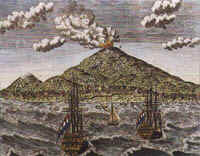
TERNATE CHAVACANO
Researched and written by: Zamboanga.com®

Ternate Chavacano (TC), which was a Creole of the region's then dominant Portuguese language influence from traders and the local Castilian Spanish from the Jesuit missionaries, will not play any role in establishing the Early Chavacano de Zamboanga (ECDZ). TC was initially merged with the early Cavite Chavacano (CC) when the Spanish garrison of the Ternate Island in the Moluccas was recalled by Governor Sabiniano Manrique de Lara to help defend Manila from Koxinga's threat of attack, when he signed a decree on May 6, 1662.
The Jesuit priests who were in charge of spreading the Spanish King's religion in the Ternate, Moluccas area took with them a group of the locals whom they have already converted, along with the garrison troops. Their destination was Manila, Philippines and the Cavite naval base nearby is where they landed. The Cavite Chavacano was more dominant at this time period inside the Cavite fort, with more speakers than the new ship load of Ternateños, and will thus provide more influence on the Ternate Chavacano.
Neither CC or TC will make their way to Zamboanga until 1718, when reinforcements were called upon to reconstruct the demolished San José Fort. Therefore, CC and TC will have their own independent history of Creolization from 1662-1718.
However, unbeknownst to published historians and linguists until now, the Early Chavacano de Zamboanga will provide a measurable role in influencing the Cavite Chavacano and the Ternate Chavacano when the hundreds of Zamboanga's recalled garrison troops, along with the new Chavacanos, brought with them their twenty-seven (27) year old ECDZ, and subsequently introduced it into the lexicon of the Cavite fort. Consequently, the Early Chavacano de Zamboanga will thereby imbed its distinctive footprint into the Cavite fort and its causal Ternate neighborhood area's Chavacano Creole development and evolution for the next fifty-six (56) years!
In an act of fruitful reversion, the ECDZ will make its triumphant return to its birthplace in 1718, albeit as an integral part of a new Creolized language of troops and helpers from Cavite (CC) and Ternate (TC) sent to help rebuild Zamboanga's damaged San José Fort, which was eventually re-named Real Fuerza de Nuestra Señora del Pilar de Zaragosa. The subsequent blending of these three popular Philippine Creole languages has led to the further enrichment in the syntax base of the influential Chavacano de Zamboanga (CDZ).
We will also provide herein a new hypothesis as to the possible makeup of these Ternate transplants. We venture to say that some of them may be descendants, or the actual slaves, who were taken by the Moro Pirates from the many islands in the Visayas and sold as slaves, and were more than happy to return to their homeland. Their strong ethnic origin and sense for "freedom" may have also influenced their desire to distance themselves from the Cavite influence, thereby creating their own "home away from home" and their form of Chavacano. Hence, there may be some influence provided by the Visayan Chavacano early on.
Also, history notes that when the Spanish rulers from Manila conquered the Ternate kingdom in 1606, the Spaniards took their king, crown prince, and other high nobles back with them to Manila. Could it be possible that their descendants in Manila made connection with the above Ternate transplants and invariably joined together their ethnic similarity?
It was well known and historically documented that the Moro Pirates actively sold their Visayan captives as slaves to the rulers of the Spice Islands, presumably to work on the bountiful spice production and global trade of these vital islands. The Ternate Island was the one controlled by the Spaniards, and the Jesuits again were the source of the populace's religion and education. Sadly though, the so called linguistic experts who have "researched " the history of Philippine Chavacano never have given the plausible influence these worldly Jesuits may have provided in the creation and proliferation of the Chavacano Language. Nevertheless, we will!
We will conclude for now that the Jesuits too can be historically considered the creators of the "Ternate Chavacano."
Stay tuned. There's more to come...
Zamboanga City History
1/22/2004
[http://www.zamboanga.com/footer.htm]